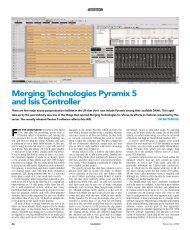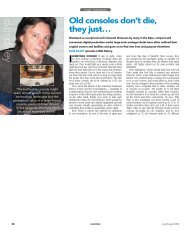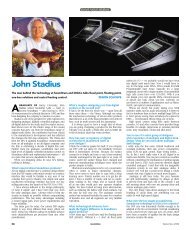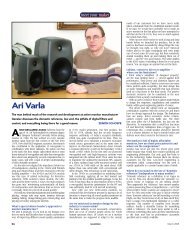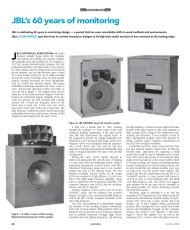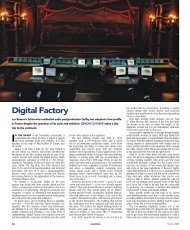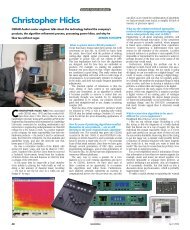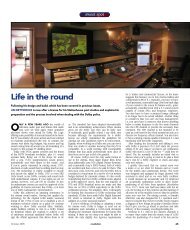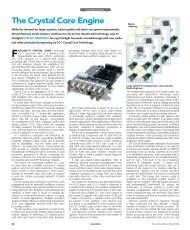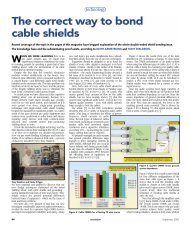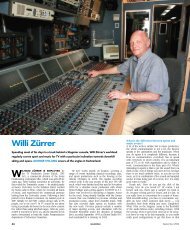SSL Duality - Resolution
SSL Duality - Resolution
SSL Duality - Resolution
You also want an ePaper? Increase the reach of your titles
YUMPU automatically turns print PDFs into web optimized ePapers that Google loves.
eview<br />
Multiple TFT screens offer a lot more information<br />
than a conventional meterbridge with automation<br />
fader position, analogue level and workstation level.<br />
Processing assignment in each of the two paths is also<br />
shown. When it comes to resetting the console, each<br />
screen can be paged through the settings for each<br />
of its six associated channel strips. Therefore multioperator<br />
Total Recall becomes possible, speeding up<br />
the process to the point where it is almost painless.<br />
Total Recall on steroids.<br />
Talkback, listen, slate and red-light control are<br />
included as expected. All audio interfacing appears<br />
on 25-pin Sub-D connectors on the rear of the<br />
console. Thanks to comprehensive logical patching<br />
the need for external manual patching is considerably<br />
diminished when compared with a conventional<br />
analogue console. The external patchbay can be<br />
significantly reduced with consequent cost and space<br />
savings. To extend the console in the same style an<br />
optional Producer Table will be available along with a<br />
patchbay module.<br />
The built-in automation offers fader and cut and<br />
is always slave to an external clock source. <strong>SSL</strong><br />
has experimented with full dynamic automation for<br />
analogue consoles but has concluded that it is just too<br />
expensive and cumbersome to implement properly.<br />
Automation can also be written to the workstation<br />
under control. A few unassigned keys in the centre<br />
section allow for future software developments.<br />
While the console obviously works quite happily<br />
in stereo, 5.1 is certainly not an afterthought. <strong>Duality</strong><br />
is an up-front acknowledgement that 5.1 is here to<br />
stay as the de facto surround format driven by the<br />
requirements of HDTV. 5.1 music for its own sake is<br />
still regrettably rare.<br />
The marriage between analogue console and DAW<br />
control is the most obvious manifestation of split<br />
personality. DAW control is basically the same as the<br />
AWS 900, which means multiple HUI for Pro Tools<br />
and Mackie Control for workstations that can use this<br />
protocol. Pro Tools has a limit of 32 faders for HUI<br />
control, something not shared by most of the other<br />
DAWs, such as Nuendo and Sonar, which can currently<br />
use up to 48 <strong>Duality</strong> faders. Every eight faders require a<br />
MIDI DIN socket. There are eight of these, one is used<br />
for MTC and one is for ‘future expansion’.<br />
The fader and rotary above it control console and<br />
workstation levels respectively. These controls can be<br />
flipped at a button press to put the workstation level<br />
control on the faders, in effect ‘layering’ the console.<br />
Of the two basic approaches to DAW control,<br />
HUI/Mackie Control or proprietary protocols, the<br />
former is more common. <strong>SSL</strong>’s choice of these<br />
protocols means <strong>Duality</strong> will work with all major<br />
workstations, including Pyramix, Pro Tools, Nuendo,<br />
Logic Audio, and many others. Ultimately though,<br />
control performance will depend on the DAW. The<br />
same applies to DAW automation. The analogue fader<br />
and mute benefit from the on-board <strong>SSL</strong> automation<br />
while the workstation automation is dependent on the<br />
DAW under control.<br />
A large, four-button trackerball with concentric<br />
shuttle wheel connected to the workstation is mounted<br />
in the armrest. The rest of the DAW controls are<br />
almost identical to the AWS-900. This means a lot<br />
of dedicated buttons (<strong>Duality</strong> has an extra row), a<br />
5-inch TFT with soft keys and rotary encoders,<br />
transport control keys plus jog/shuttle.<br />
Plug-ins can be controlled from the screen,<br />
encoders and softkeys in the centre section or, in<br />
Mackie Control mode, you can have up to 48 faders<br />
controlling a plug-in ‘horizontal’ style, ideal for<br />
complex instruments. It is easy to become obsessed<br />
with being able to control every last workstation<br />
function from the console but this rather misses<br />
the point. Providing there is adequate control when<br />
tracking and mixing it will often be quicker and easier<br />
to use mouse and keyboard for complex editing,<br />
especially for the generations weaned on computers.<br />
Some of the less visible features also warrant<br />
attention. There is a lot of surface mount componentry<br />
in <strong>Duality</strong>. This brings potential reliability benefits<br />
and also considerably reduced power consumption.<br />
Each bay of 24 strips requires one IEC mains cable<br />
and that’s it. Current draw is remarkably low at<br />
around 600W for a 48-channel board resulting in<br />
air conditioning savings and at least one prospective<br />
client reckons he will save one monthly lease<br />
payment a year on energy savings alone. Since all<br />
the processing and power supplies are contained in<br />
the surface there is no longer any need to waste<br />
space on a separate machine room.<br />
Although <strong>Duality</strong>’s internal intelligence uses <strong>SSL</strong>’s<br />
proprietary processors rather than a disguised PC,<br />
there is an Ethernet port to communicate with an<br />
external computer. The new Studio Browser software<br />
is not only for housekeeping, along with the built-in<br />
CompactFlash socket, but in the future will also offer<br />
other possibilities. One <strong>SSL</strong> innovation is dubbed<br />
‘Eyeconics’. This allows a small image to be placed<br />
in the screen above each channel strip making<br />
identification of sources intuitive and of course there<br />
is no language barrier. <strong>SSL</strong> provides a library of icons<br />
and, via the Studio Browser, users can add their own<br />
pictures (You can imagine where this will lead. Ed).<br />
On the face of it <strong>Duality</strong> could be seen simply as<br />
the AWS 900’s bigger brother but when you see it<br />
in the metal there is a lot more to it. This console<br />
has an instant air of rightness about it, in the ‘big<br />
gun’ console sense. There is real gravitas that the<br />
AWS 900 has never quite achieved. Not only will<br />
upper-end project studio owners like it but it has client<br />
appeal as well. The console is available in 48-, 72- or<br />
96-channel configurations with UK£130,000 as the<br />
entry point. Extra 24-channel bays can be added to<br />
48 or 72 frames as a retrofit.<br />
The face of music recording is changing once<br />
again. <strong>SSL</strong> is convinced there has been a resurgence<br />
in the middle level studio market, driven at least<br />
in part by the current popularity of bands playing<br />
‘real’ instruments. So what is <strong>Duality</strong>? An <strong>SSL</strong> for<br />
the ‘Noughties’ perhaps as at the time of writing<br />
three 48s and a 96 have already been sold. It offers<br />
a number of distinct sound signatures and, for a lot<br />
of music production, this is exactly what is required.<br />
Continuing the split personality theme, the dual<br />
architecture with split signal path allows you to route<br />
the signal through the channel strip in several ways.<br />
It gives you the best of both worlds, you can track<br />
using mix sound and it’s all easy to configure. You<br />
can do these things on a traditional console, but with<br />
lots of patching and messing about. Unlike the AWS<br />
900 every channel has dual dynamics and dual filters<br />
so this is a true large format analogue console in the<br />
<strong>SSL</strong> tradition.<br />
For me, variable harmonic drive is certainly one of<br />
the stars of the show. In the short time I spent with the<br />
console this feature transformed some very ordinary<br />
drum sounds into something far more interesting<br />
and an equally ordinary bass guitar into something<br />
reminiscent of late 1960s Colosseum.<br />
Where the AWS 900 is more obviously an adjunct<br />
to a DAW, <strong>Duality</strong> is a distillation of <strong>SSL</strong>’s analogue<br />
wisdom with digital control expertise. The internal<br />
patching and multiple-operator Total Recall make<br />
this a very quick and intuitive console to operate.<br />
The DAW facilities are a recognition of the facts of<br />
modern recording life. They are here to stay, they’re<br />
not going away, so we may as well get used to it.<br />
<strong>Duality</strong> gives us an interesting glimpse of where the<br />
future may lie. ■<br />
pRos<br />
cons<br />
contact<br />
Mid-range analogue lives!; at last, some<br />
analogue console innovation; fast and<br />
productive; interesting sounds at a<br />
touch.<br />
Workstation control, especially with pro<br />
Tools, is out of scale with the console<br />
i.e. limited to 32/48 strips; more 5.1<br />
compressors would have been useful.<br />
soliD sTaTe loGic, Uk:<br />
Website: www.solid-state-logic.com<br />
October 2006<br />
resolution<br />
23





